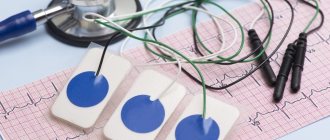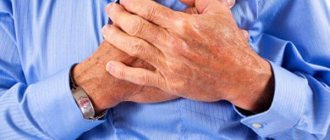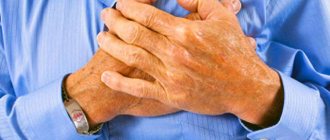Are bradycardia in children and sports compatible? Which section is not suitable for a child with this disease? And, on the contrary, what kind of sport will be useful for him? You will learn about this from our article.
Bradycardia is a disease in which the heart rate decreases. In order to understand what heart rate indicators are considered low, we will learn about the norms.
Children of different ages have their own heart rate (HR):
- Newborns: 140-160 beats per minute;
- Up to a year: 120-140 beats per minute;
- Up to 5 years: the average heart rate reaches 100 beats per minute;
- At 8 years: 90-100 beats per minute;
- At 10 years old: 80-85 beats per minute;
- At 12 years and older: 70-75 beats per minute.
If we take into account the listed values, then a decrease in heart rate of 120 beats per minute or less in infants will be considered bradycardia. For preschool children this is below 70, and for schoolchildren it is 62 or less.
Symptoms of bradycardia
- Semi-fainting, attacks of loss of consciousness or dizziness during a decrease in pulse.
- Arterial hypertension, unstable blood pressure.
- Increased fatigue even after minor physical activity.
- Chronic circulatory failure.
- Angina pectoris of exertion and rest in combination with a decrease in heart rate.
- Weakness.
- Cold sweat.
- Pain in the heart area.
- Shortness of breath (uncharacteristic symptom).
Severe bradycardia
(less than 40 beats per minute) is a very dangerous condition that can cause the development of heart failure, and therefore the patient may require surgery to implant a pacemaker.
Diagnosis of bradycardia in athletes
To identify cardiac bradycardia during sports, it is necessary to undergo a comprehensive medical examination; it is not possible to independently identify the disease during physical activity.
To determine the degree and severity of bradycardia during physical activity, it is necessary to undergo the following studies:
- Electrocardiography.
- Echocardiography.
- Comprehensive clinical assessment.
- Stress Testing.
Typically, athletes only need to undergo an ECG. Other research methods are necessary if there are symptoms of pathological bradycardia in order to exclude other diseases.
Factors in the development of bradycardia
- Sclerotic changes in the myocardium - the muscular layer of the heart, affecting the sinus node.
- Increased tone of the parasympathetic nervous system.
- Increased intracranial pressure (with cerebral edema, tumor, meningitis, cerebral hemorrhage).
- The effect of certain medications for the treatment of cardiovascular diseases (beta blockers, antiarrhythmics, etc.).
- Toxic poisoning with lead, nicotine.
- Hypothyroidism is a decrease in thyroid function.
- Starvation.
- Age-related changes in the heart.
- Diseases of the cardiovascular system (atherosclerosis of the coronary vessels, ischemic heart disease, cardiosclerosis, heart attack, endocarditis, myocarditis, post-infarction scars, etc.).
- Disorders of the metabolism of minerals and electrolytes involved in conducting electrical impulses in the heart.
- Obstructive apnea (stopping breathing during sleep).
- Infectious and inflammatory diseases (rheumatism, systemic lupus erythematosus).
- Hemochromatosis (accumulation of iron in organs and tissues).
- Some diseases not related to the functioning of the cardiovascular system (typhoid fever, jaundice, etc.).
Good and bad sports
If you have bradycardia, it is not recommended to engage in the following sports:
- skis when skating;
- cycling;
- football;
- skates;
- Athletics.
The following sports are allowed:
- swimming;
- hockey;
- golf;
- rowing;
- sports wrestling.
Types of bradycardia
- Absolute bradycardia
- a decrease in heart rate (heart rate) is constant and does not depend on the conditions in which the patient is located. - Relative bradycardia
is a decrease in heart rate under certain conditions (after physical activity, against the background of diseases - fever, traumatic brain injury, typhus, meningitis), a lag between the increase in heart rate and the increase in body temperature. This group also includes “athletes’ bradycardia” – a decrease in heart rate in well-trained people when they perform certain physical exercises. - Moderate bradycardia
- most often observed in children suffering from respiratory arrhythmia during deep inspiration, during sleep, or in the cold. Bradysphygmia, a rare pulse with a normal heart rate, should be distinguished from bradycardia. - Extracardiac vagal bradycardia
– observed in patients suffering from neurological diseases, diseases of internal organs, kidney diseases (nephritis), myxedema and other diseases. - Depending on the reasons that caused bradycardia, physiological and pathological bradycardia are distinguished. Pathological bradycardia is represented by two main forms - sinus bradycardia and bradycardia due to heart block.
Medical indications
Among the main symptoms of bradycardia in children are:
- pale skin;
- fast fatiguability;
- shortness of breath;
- dizziness that occurs in attacks;
- pain in the chest area;
- fainting and semi-fainting states.
To prevent bradycardia and reduce symptoms, doctors advise following a special diet:
- Drink as much fluid as possible. Ideally, one and a half to two liters per day.
- Eat a lot of vegetables. It’s good if carrots, parsley, and cabbage predominate in the diet.
- Give preference to lean meat.
- From fruits, choose apples, bananas and citrus fruits that are good for your heart.
- Eat fermented milk products.
- Don't give up seafood.
In addition to diet, hardening and moderate physical activity are useful.
When choosing a sport for a child with cardiac bradycardia, its degree should be taken into account. To do this, you need to do an ECG, which will help you understand what kind of bradycardia is taking place: sinus or heterotopic.
Be sure to consult a cardiologist. It will help you decide on the type of load that will be optimal for a particular type and diagnosis.
Complications of bradycardia
Rarely bradycardia
can also occur in healthy people.
A moderate degree of bradycardia
is not dangerous and does not cause serious disturbances in the functioning of the cardiovascular system.
However, if attacks of bradycardia
are repeated, this can lead to a lack of blood supply and oxygen starvation of organs and tissues, as a result of which their full functioning is disrupted. Acute oxygen deficiency can cause Morgagni–Adams–Stokes syndrome, in which a sudden loss of consciousness occurs.
A more serious complication of bradycardia
is the depletion of the myocardium - the heart muscle, which occurs as a result of fibrillation of the ventricles of the heart. Over time, rupture of the heart muscle (myocardial infarction) and death are possible.
Heart during regular exercise
Excessive physical activity causes an athlete's body to change.
Some changes also occur in the circulatory system. The modification is associated not only with loads, but also with an active regime and regular training. Transformations in the circulatory system allow the athlete to withstand such a lifestyle. Reference! Some changes also occur in the athlete’s heart - unlike the heart of an ordinary person, it has an increased size of the myocardium and cardiac sinuses.
Treatment of bradycardia
Treatment of bradycardia
at GUTA CLINIC it begins with a correct diagnosis - after all, the successful outcome of treatment depends on establishing the exact cause of the disease.
If, against the background of a decrease in heart rate, no diseases that could cause bradycardia
are diagnosed, and there are no symptoms of the disease, then
bradycardia
is not treated
- If a slow heart rate is caused by a medical condition, such as hypothyroidism or electrolyte imbalance, correcting the problem is usually enough to stabilize your heart rate.
- If bradycardia
is a consequence of taking any medications, the attending physician will recommend reducing the dose or prescribing an analogue of the drug being taken that does not cause changes in heart rate. If for some reason it is not possible to take these measures, the patient may be recommended to have a pacemaker implanted.
Regardless of the cause of the disease, treatment of bradycardia
is to bring the heart rate to a level at which the blood supply to the body is sufficient.
Untreated bradycardia
or its incorrect treatment can lead to quite serious consequences - from fainting and general deterioration in health to paroxysms and death.
Diagnosis of bradycardia
at GUTA CLINIC it is carried out using the most modern expert-level equipment, and treatment is carried out by highly qualified cardiologists, candidates of medical sciences and doctors of the highest qualification category, who regularly improve their knowledge and exchange experience with foreign colleagues.
Many of our specialists have completed internships and training in the largest specialized medical centers in Europe and the USA, and have a number of scientific publications on the diagnosis and treatment of cardiovascular diseases, incl. and bradycardia
.
Treatment of bradycardia
at GUTA CLINIC it is carried out individually depending on the patient’s age, symptoms, characteristics of the course of the disease, the form of bradycardia and other individual indicators.
The cardiologists at GUTA CLINIC have hundreds of successfully treated patients with various forms of bradycardia
, including complicated ones.
Features of heartbeat during sports activities
The human heart has excellent adaptability to increased physical stress. For sports fans, due to regular training and an active regime of the body, some transformations in blood circulation begin, thanks to which the athlete can have the greatest performance under significant physical exertion.
Due to training, the heart muscle becomes larger in volume along with stretching of the sinuses of the heart. Such myocardial hypertrophy quickly disappears, which is facilitated by the removal of overstrain on the heart.
Bradycardia is a decrease in the frequency of contractions of the heart muscle to 50 beats per minute or less.
Cardiac contractions, namely their frequency, are associated with the ability of the heart muscle to contract under an impulse effect that originates in the myocardium.
This rhythm disturbance in people who like to play sports matures against the background of repeated physical activity. Under the influence of such reasons, the active mode of the body changes.
This means that a reduced number of myocardial contractions per minute is the norm for the delivery of nutrients and oxygen delivered with blood to the tissues of the human body. But it happens that bradycardia can be a serious sign of pathological conditions in athletes.
Normal functioning of the sports heart in pathology
Correct and regular exercise, the so-called sports heart, is a normal process, which gives the athlete greater ability to work and the opportunity to play sports without any worries about his own health.
The peculiarity of such a cardiac muscle makes it possible to combine its relatively economical work at rest with options for high performance under physical loads.
The absolute and economical work of the heart lies in the fact that the number of heart contractions drops to 50 or less beats per minute (the result of bradycardia) and this occurs with relatively normal hemodynamics of the body.
In this situation, the tissues of the human body are provided with nutrition, which develops a whole network of additional small blood vessels, namely capillaries, leading, among other things, to the heart muscle.
Increasing the size of the heart muscle in athletes has certain limitations. A large heart volume, reaching 1200 or more, leads to the risk of a pathological condition of the heart muscle. In this connection, we can conclude that such amateurs require constant medical supervision.
Even with normal functioning of the trained heart muscle, bradycardia after the start of training can turn into tachycardia. Literally within seconds, the number of heart contractions increases several times and reaches more than 170 beats per minute.
But thanks to certain reserves, the body adapts to such a number of heart contractions and to such needs of the body. But after some time after training, the number of contractions quickly recovers.
Pathological condition of the sports heart in pathology
The athlete’s entire body reacts negatively to a non-gradual and sharp increase in physical work processes or the occurrence of any infectious processes, which gives rise to the development of various pathologies of the heart muscle.
Such a change with obvious pathology - the athlete's heart is increased in size, which affects the performance of the athlete's entire body.
All these nuances occur due to a significant increase in the volume of the heart muscle, which worsens its blood circulation and leads to the development of oxygen starvation of individual myocardial muscle tissues, as well as to their possible necrosis, as a result of which one can expect the development of a microinfarction.
Atrophied muscle fibers are replaced by connective tissue, resulting in the development of cardiosclerosis. Naturally, the performance of such a heart decreases significantly.
Cardiosclerosis (scars on the heart)
The degree of bradycardia and the athlete’s state of training often do not correspond to each other. Many athletes with this diagnosis are not adapted to stress; they have reduced performance, fatigue quickly, poor sleep, and more.
The number of contractions of their heart muscle may be below 40 beats per minute, which requires constant attention from doctors to such people.
It is in such sports fans that the presence of a pathological condition of the sports heart can be identified.
Disorder in young athletes
If bradycardia is diagnosed in teenage athletes, it, just like in an adult, does not require drug therapy. This is how the body adapts to new living conditions and increased physical activity.
This condition is dangerous when the following symptoms occur:
- change in the shade of the epidermis, the appearance of pallor;
- dizziness and fainting;
- weakness;
- headache;
- dyspnea;
- cold sweat.
Important! In this case, you should immediately consult a doctor.
If a child is diagnosed with bradycardia, the following sports are contraindicated:
- Horseback Riding;
- diving;
- judo;
- karate;
- skiing;
- cycling;
- gymnastics.
Allowed sports:
- rowing;
- volleyball;
- golf;
- swimming.
Professional sports activities lead to the development of bradycardia. In some cases, this condition can cause serious diseases. To prevent this from happening, it is recommended to contact a specialist immediately after discovering the problem.











